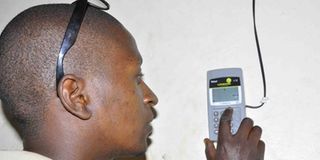Yaka: Why units vary for similar amounts

A man checks a Yaka meter in Kampala. Some customers wonder why for the same amount the receive varying units. Photo by Stephen Otage
What you need to know:
The argument. For similar a amount a customer can be given varying units depending on earlier usage. However, some customers say even with zero outstanding balance, some have received varying units.
It is three months since Ahimbisibwe (first name withheld on request), a teacher, switched from electricity distribution company, Umeme’s, postpaid billing to prepaid.
While she was on postpaid, she would spend Shs20,000 monthly, which would get her units that would take her through a month.
“Now that I am on prepaid, the number of units Shs20,000 buys fluctuates,” Ms Ahimbisibwe says.
At first, Shs20,000 got her 47.6 units but they later dropped to 23, before rising again to 24.7 and 30 units.
She uses electricity to light six 20–watt each ‘energy savers’, iron clothes once a week and to run a refrigerator. “I am confused,” she says.
From 2015 to 2018, Umeme will convert 375,000 postpaid meters to prepay.
Checking illegal power usage
The move seeks to check illegal tapping of electricity, which accounts for seven of the current 20 per cent energy losses.
For the 375,000 customers who will be switched from postpaid to prepaid, an experience similar to Ahimbisibwe might suffice.
In this article, this newspaper explains why a fixed amount of money buys different units of electricity.
As a Umeme contractor replaces a postpaid meter with a prepaid one, he or she notes the reading on the postpaid meter and the outstanding bill.
The customer is then advanced 30 preloaded prepay units.
The next time the customer buys units, 30 per cent of the outstanding postpaid arrears, if any, are deducted.
Also, 10 per cent of the amount a consumer tenders in goes to clearing the debt due for the preloaded units.
“We [Umeme] have to recoup the cost,” Richard Sserunkuma, Umeme’s prepayment coordinator and systems conversion manager, says.
“A postpaid customer is known by his or her account number whereas a prepaid customer is known by his or her meter number. We need to link the two. When you purchase Yaka units before we link the two, you will get ‘more units’ because we would not have activated our debt recovery,” Sserunkuma adds.
The deductions continue until the outstanding balances are cleared.
Clause 4.4.1 of the Guidelines for Implementation of Prepaid Metering by Electricity Distribution Licensees (2014) provide for these deductions.
A customer could ask the company to deduct the arrears at the time of the switch. However, many of them do not know this and might not be informed by Umeme staff.
Given that 40 per cent goes to clearing the outstanding bills, whatever is left for the fresh units is less.
However, Ahimbisibwe does not agree with the notion that she is clearing her previous bill given that as she says she had cleared her bills two months upfront.
But other reasons to explain why a fixed amount buys different units – especially if spread across quarters – are the forex rate, fuel costs and inflation rates, which impact on the cost of electricity.
Also, the distributor deducts the Value Added Tax, which varies and passes this onto URA.
Once every month, Shs3,360, which is a service fee, is deducted from a customer, which means that if he or she buys units twice within the same month, they will vary because of one of the tokens will be less the service fee whereas the other will not.
375,000 to be switched from postpaid to prepaid
Power distributor, Umeme, will switch 375, 000 customers from postpaid to prepaid billing between now and 2018.
Over the same period, it is projected to make 278,000 new connections, all prepaid, according to the company’s Annual Tariff Review for 2015 says.
Umeme will spend $109m (Shs363b) on the exercise with the funds to come from shareholders equity and loans.
Prepayment billing seeks to check illegal tapping of electricity, which accounts for seven of the current 21.6 per cent energy losses.
Some people tap power, claiming the end–user electricity tariffs are high, and, thus, unaffordable.
Each energy loss, according to the sector regulator, Electricity Regulatory Authority, costs Uganda $3m (Shs9.9b).
Also, to check on commercial losses, Umeme will start using insulated cables so that people cannot hook wires on to the cables to tap electricity.
It will also lay underground cables in some areas with the hope that the people bent on not paying for electricity will not burrow through the ground to connect themselves to power.
To mitigate technical losses, the company will install more transformers especially in the areas of exponential growth to shorten distances since more electricity is lost when transported over longer distances. Through these measures, Umeme projects to reduce overall energy losses from 20 per cent to 14.7 per cent by 2018. The government, too, is contributing towards reducing energy losses.
In January, ERA revised fines for illegally using electricity.
ERA chief executive officer, Dr Benon Mutambi, said this had been done to “discourage power theft and to reduce commercial losses”.
Households and small shops that illegally use electricity will pay a fine of Shs350,000 instead of Shs295,000.
Commercial users convicted of illegally using electricity will pay Shs700,000 up from Shs590, 000.
And industrial consumers will pay Shs1.4m instead of the Shs1.18m should they be convicted of stealing electricity.
Its advantages notwithstanding, some customers say the prepayment system is prone to outages, especially whenever it rains.



